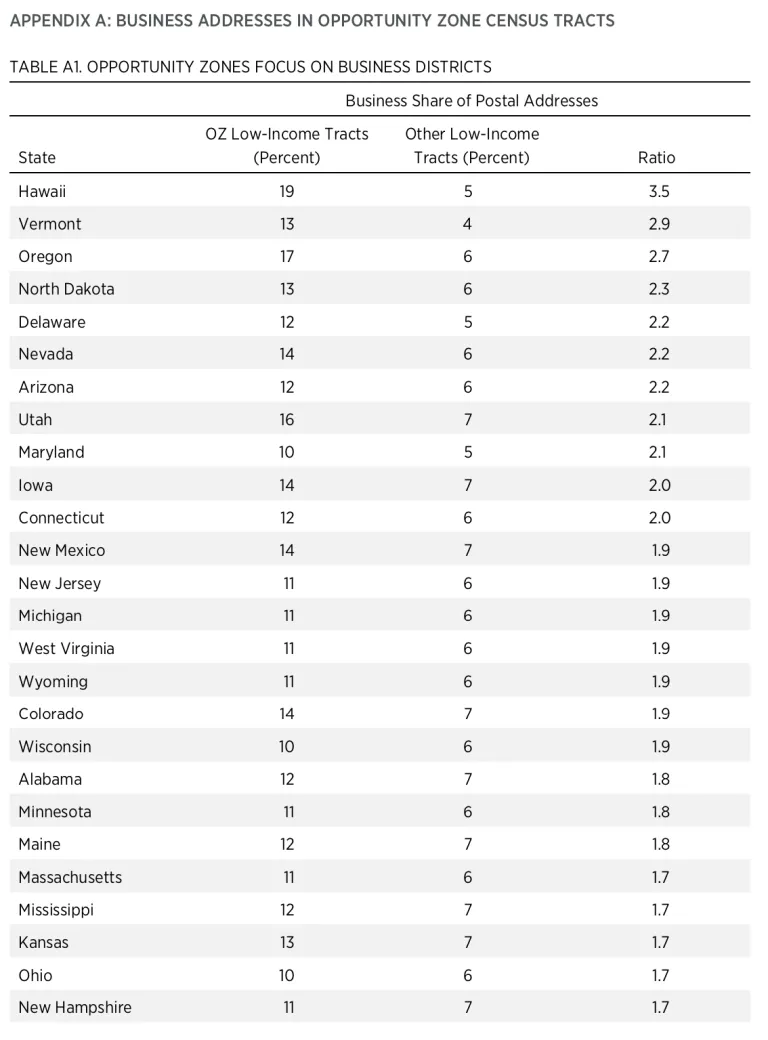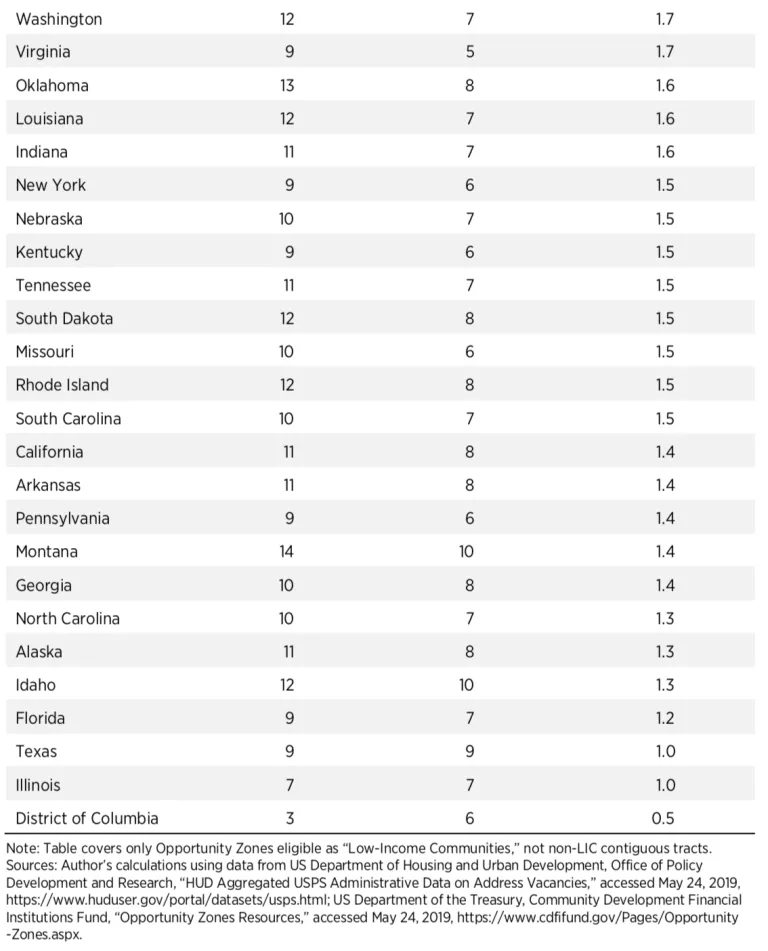- | Housing Housing
- | Public Interest Comments Public Interest Comments
- |
HUD Does Not Need to Target Opportunity Zones
Thank you for the opportunity to comment on the Department of Housing and Urban Development’s (HUD’s) actions in response to the creation of Opportunity Zones and Executive Order 13853, “Establishing the White House Opportunity and Revitalization Council.” The Mercatus Center at George Mason University is dedicated to bridging the gap between academic ideas and real-world problems and to advancing knowledge about the likely consequences of proposed regulation for private markets. Accordingly, this comment represents the views of no particular party or interest group.
HUD should avoid adding administrative complexity by targeting Opportunity Zones and should continue to improve the administration of its many long-standing programs intended to benefit economically distressed communities. Opportunity Zones do not, by design or intent, align closely with HUD’s goals. In addition, Opportunity Zones are complex geographies; targeting them would add administrative burdens to HUD’s relationships with states and localities. Instead, HUD should work to simplify existing administrative procedures wherever possible.
Opportunity Zones Do Not Align with HUD’s Goals
The Tax Cut and Jobs Act of 2017 creates Opportunity Zones to reward investment in particular census tracts designated by governors in each state. Qualifying investment in Opportunity Zones receives substantial tax abatements. Governors are asked to designate a specific number of census tracts in their states. Selected areas have to have moderately high rates of poverty or below-average resident incomes, but the areas can already be successful business districts.
Given the opportunity to select Opportunity Zones, governors can take several considerations into account:
- Very depressed or isolated areas might be most deserving of tax breaks.
- Relatively thriving areas might attract the most investment.
- Politics might dictate the need to distribute Opportunity Zones to every part of a state or to disproportionately focus on politically important areas.
In Oregon, the selection of thriving downtown Portland as an Opportunity Zone has earned mockery. Portland is already expensive, and its growth is constrained by strict land use regulations, including an urban growth boundary, extensive single-family zoning, and a stifling affordable housing mandate. Pushing housing prices still higher in Portland would exacerbate the divide between the booming metropolis and economically stagnant areas elsewhere in the state. Nonetheless, the choice was rational given the incentives involved.
The same incentives exist in a city with a generally depressed economy. The city’s low-income residents will benefit most if the governor designates their likely workplaces, not their homes, as Opportunity Zones. This is clearly on display in Rochester, NY. With virtually the entire city eligible for Opportunity Zone status, the entirety of downtown was included. Likewise, Monroe County, NY, census tract 114—which contains the Xerox Corporation campus in affluent Webster—was designated. This is not necessarily corrupt or irrational. Xerox’s Webster campus competes for investment with Xerox locations worldwide, and it is a more likely location for a major investment than one of the many primarily residential neighborhoods that could have been chosen instead.
Nationwide, there is a clear trend in Opportunity Zone selection toward census tracts with strong business presences. In the average low-income Opportunity Zone, the share of business postal addresses was 10 percent, as compared to 6.8 percent in the average low-income census tract that was not designated and 5.9 percent in the average high-income tracts.
Table A1 (see page 5) shows that the degree to which states favored business-heavy tracts varied, from an extreme degree of selection in Hawaii and Vermont to parity in Illinois and Texas. Only the District of Columbia favored tracts with fewer business addresses.
Unlike the Opportunity Zone program, which is focused on business investment, HUD’s activities and priorities are centered on residential areas. At their best, Opportunity Zones will complement HUD’s residential efforts.
Targeting Opportunity Zones Would Involve Additional Administrative Burden
Administration is the translation of intent into action. It cannot be dispensed with and should not be ignored. What begins in Washington as the most high-minded policy intent ends up—if successful—as an uninspiring tangle of paperwork and payments. Opaque paperwork and payments can undermine the best-intentioned program, so policymakers ought to spend relatively more time simplifying administration and relatively less imagining new programs.
Connecting existing HUD programs to the new Opportunity Zone designation would add administrative complexity. Many HUD programs already have a designated geography, which may be better targeted to the relevant needs of an area than Opportunity Zones are. Since census tract boundaries do not generally align with municipal boundaries, Opportunity Zones do not fit neatly into HUD’s existing relationships with municipalities and public housing authorities.
Targeting existing HUD programs to the new Opportunity Zone designations would, in many cases, require an additional dimension of review by HUD staff and applicants for HUD funding. Imagine that Rochester applies for a grant to perform lead abatement. Under a hypothetical HUD rule prioritizing Opportunity Zones, staff at the City of Rochester would have to start tracking whether abatement-eligible properties are in Opportunity Zones. HUD staff would receive this data and add it to the existing multidimensional process for deciding among lead-abatement grant applicants. Adding “Opportunity Zone share” to the existing criteria—which are (hopefully) directly relevant to the efficacy of lead abatement—would slightly dilute those criteria. Since Opportunity Zones were not designated with lead abatement in mind, the result would be slightly more administrative burden, slightly less effective spending on lead abatement, and a slight deterioration in public health. It’s not worth it.
Improving Existing Administrative Procedures
Unglamorous and uncreative though it is, the simplification and clarification of existing administrative procedures is a more fruitful avenue for HUD efforts than incorporating Opportunity Zone designations into department policy. In some cases, HUD programs are so administratively burdensome that the department cannot give money away; this was the case with HUD lead abatement grants to Washington, DC.
Improvement in administrative procedures requires HUD’s leadership to deeply research the process in an individual program and to identify the necessary tradeoffs. In the case of lead abatement, HUD requires that grantees verify the income of every beneficiary household. Since most of the intended beneficiaries are renters, this can be difficult. Who wants to give their landlord updates on their income? In this case, HUD could ease administration by automatically qualifying properties in high-poverty census tracts. It would not make sense to include only Opportunity Zone tracts, though, since some of the highest-poverty tracts (such as Monroe County, NY, tract 79, with a 61 percent poverty rate) are not Opportunity Zones and some Opportunity Zones tracts are middle income.
An Exception: HUD Homes
In one instance, HUD’s goals do align with the investment incentives in the Opportunity Zone program. HUD has a small portfolio of foreclosed homes that any potential buyer can view at the online “HUD Home Store.” The numbers are small—there are 72 properties for sale in Virginia as of this writing. It is in HUD’s interest to return these homes to gainful occupancy quickly and to recoup some of the costs of foreclosure in the process.
Qualified Opportunity Funds (QOF) are potential buyers. At present, they would have to evaluate whether specific properties are in Opportunity Zones on a property-by-property basis. Adding an Opportunity Zone tag to the correct properties in the HUD Home Store and creating a fact sheet for QOF investors may be worthwhile.
Conclusion
HUD already has Revitalization Areas, Entitlement Communities, Empowerment Zones, Choice Neighborhoods, Qualified Census Tracts, and Promise Zones. On its own, each seems to offer the possibility of federal investment lifting up a depressed locality and overcoming the cycle of concentrated poverty. Listed together, they indict one another: the last generation’s effort at place-based policy fell short, so rather than evaluate and reform it, it was left in place and a new policy with a new map was overlaid on top of it. Place-based policy may or may not work, but place-based politics is clearly broken.
HUD has little to gain from directly targeting the census tracts chosen by governors to attract business investment. Instead, HUD should apply its efforts to making its existing programs simpler and more transparent.


Additional details
Review of HUD Policy in Opportunity Zones
Agency: Department of Housing and Urban Development
Comment Period Opens: April 17, 2019
Comment Period Closes: June 17, 2019
Submitted: June 4, 2019
Docket No. FR-6155-N-01

